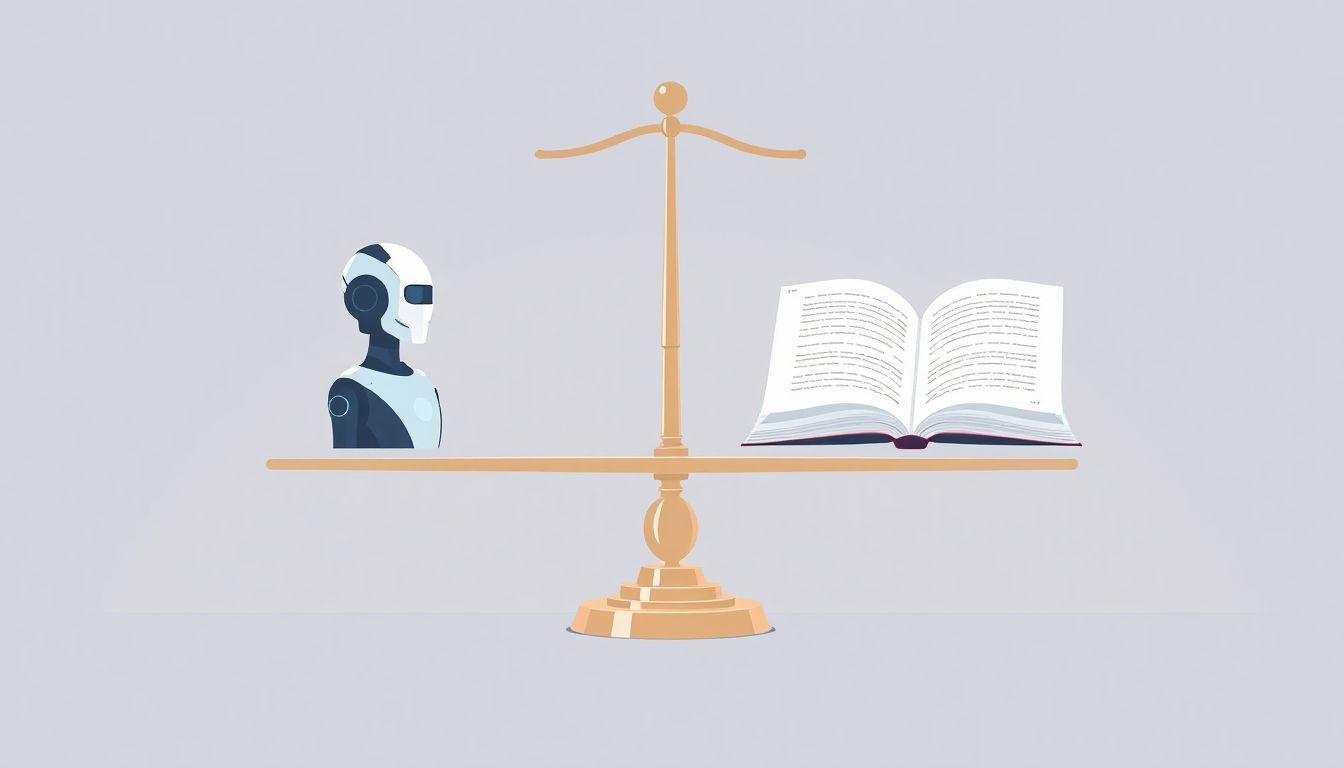Navigating the legal landscape can feel like wandering through a maze—one wrong turn, and you could be in hot water. I get it; the thought of compliance can be daunting, especially with ever-changing regulations lurking around every corner.
But what if I told you there’s a way to ease that burden? By harnessing the power of ChatGPT for compliance, you can streamline processes, reduce legal risks, and even discover clever shortcuts that save you time and stress. Sounds promising, right?
Stick with me, and you’ll find out how ChatGPT can transform your compliance strategies, making them not just effective, but also efficient. From understanding legal requirements to implementing practical solutions, we’ll cover it all!
Key Takeaways
- ChatGPT offers AI-driven solutions that automate legal guidance, making compliance easier and more efficient.
- Real-time, contextual responses help organizations interpret regulations correctly and reduce legal risks.
- It provides risk assessment capabilities to identify potential compliance threats effectively.
- Implementation involves strategic integration, focusing on training the AI on relevant legal documents and maintaining data privacy.
- Using the right prompts can streamline compliance tasks, enhancing documentation and reporting processes.
- While useful, ChatGPT requires human oversight due to potential accuracy and contextual limitations.

How ChatGPT Helps Reduce Legal Risks in Compliance
ChatGPT can significantly reduce legal risks in compliance through AI-driven solutions that offer automated legal guidance.
By utilizing compliance chatbots, organizations have access to real-time, contextual answers to compliance-related questions.
These tools can assist in mitigating legal risks by ensuring that regulations are being interpreted and applied correctly.
Additionally, ChatGPT provides risk assessment capabilities, allowing businesses to evaluate potential compliance threats more effectively.
This 24/7 legal assistance means companies are less likely to miss critical updates or compliance requirements.
Understanding Legal Compliance and Its Importance
Legal compliance refers to the process through which organizations ensure they are adhering to laws, regulations, and standards relevant to their industry.
It’s crucial for businesses to understand the importance of compliance to avoid potential legal troubles or penalties for non-compliance.
Compliance risk management involves identifying, assessing, and mitigating risks related to legal requirements.
Inadequate compliance can lead to severe penalties, damaged reputation, and loss of customer trust.
Establishing a robust compliance framework is essential for maintaining operational integrity and safeguarding the business against legal repercussions.
Key Features of ChatGPT for Legal Compliance
ChatGPT boasts several features that are beneficial for legal compliance tasks.
Firstly, its natural language understanding allows users to ask questions in everyday language, making interactions intuitive.
Contextual awareness is another strength, enabling ChatGPT to provide relevant answers based on the specific compliance context presented.
Moreover, it can generate templates for legal documents, which saves time and ensures consistency.
Real-time regulation updates serve as an invaluable feature, ensuring that organizations stay compliant even as laws change.
Additionally, ChatGPT’s capability for legal information retrieval means users can access crucial compliance data quickly and easily.
The user-friendly interface makes ChatGPT accessible for those without specialized legal knowledge.
How to Implement ChatGPT in Your Compliance Processes
Implementing ChatGPT in compliance processes involves a strategic approach to fully leverage the technology.
Start by integrating AI solutions where they can provide the most value, focusing on areas like risk assessments and document reviews.
A step-by-step implementation guide ensures that each phase of the integration is addressed carefully.
Training the AI on specific legal documents relevant to your industry will help in customizing its responses to better suit your needs.
Consider API integration with existing compliance management systems to streamline workflows and reduce redundancies.
Lastly, be mindful of data privacy and ethics when deploying AI solutions in any compliance context, maintaining a balance between innovation and responsibility.

Examples of ChatGPT Prompts for Compliance Tasks
Using ChatGPT can streamline various tasks related to compliance, provided you ask the right questions.
Here’s a curated list of effective prompts you can use for your compliance efforts:
- “Summarize our industry’s key compliance regulations and their implications for our business.”
- “Draft a compliance checklist for [specific regulation] that we need to adhere to.”
- “Generate a sample report detailing our compliance status for the past quarter.”
- “Create a legal notice template for informing stakeholders about compliance changes.”
- “List potential risks associated with non-compliance with [specific law or regulation].”
- “Provide an update on recent changes to [specific regulation] and how it affects our operations.”
- “Outline a step-by-step process for implementing new compliance measures in our organization.”
- “Explain the consequences of failing to comply with [specific regulation].”
These prompts are designed to help you harness ChatGPT’s capabilities to bolster your compliance efforts effectively.
Benefits of Using ChatGPT for Legal Compliance
Integrating ChatGPT into your compliance workflows offers numerous advantages.
First off, it provides cost-effective solutions by automating tasks that would traditionally require substantial human resources.
With its high degree of accuracy in legal interpretations, you can trust that the information you’re receiving is reliable.
It enhances decision-making capabilities by analyzing large volumes of data quickly, making it easier to identify compliance risks.
The efficiency boost in document review processes translates into faster turnaround times for compliance tasks.
If you have a growing organization, ChatGPT scales seamlessly to accommodate increased compliance needs as your business expands.
Plus, you gain 24/7 access to a wealth of legal resources, keeping your compliance efforts agile and well-informed.
Challenges and Limitations of ChatGPT in Legal Compliance
While ChatGPT is a powerful tool, it comes with some challenges that users should be aware of.
Firstly, accuracy concerns can arise, as the AI might misinterpret complex legal language or nuanced regulations.
Its contextual limitations can lead to incomplete answers if the prompts lack sufficient detail.
Data privacy issues are also critical, especially when dealing with sensitive legal information; you need to ensure compliance with data protection laws.
Over-reliance on ChatGPT can be problematic; human oversight is still necessary to validate the AI’s outputs.
Lastly, interpretation errors can occur due to the AI’s reliance on existing data, which may not always reflect the latest legal updates or changes.
Best Practices for Using ChatGPT in Legal Risk Management
To maximize the benefits of ChatGPT in your legal risk management process, consider the following best practices.
First, train your staff on how to effectively use AI tools to enhance their compliance efforts.
Regularly audit AI-generated outputs to ensure they meet your organization’s standards and to catch any inaccuracies.
Establish clear guidelines for how ChatGPT should be used in compliance processes to avoid over-dependence.
Implement feedback loops where users can report issues or improvements in the AI’s performance for continuous learning.
It’s essential to integrate human expertise with AI capabilities, creating a balanced compliance strategy.
Finally, keep an eye on the latest legal developments to ensure that your AI tool remains relevant and effective in your compliance efforts.

Future Trends: The Role of AI in Legal Compliance
AI is increasingly becoming pivotal in streamlining legal compliance processes.
One trend is the rise of predictive analytics, which helps businesses anticipate compliance risks before they occur.
Machine learning algorithms are getting better at identifying patterns that may indicate non-compliance.
This proactive approach allows organizations to navigate complex regulatory environments more smoothly.
Moreover, we can expect more integration of AI with existing compliance frameworks, automating tedious tasks and allowing legal teams to focus on strategic issues.
Another exciting development is the improvement in AI’s ability to understand and interpret legal language.
This means that tools like ChatGPT will likely become even more adept at providing accurate legal insights.
Additionally, as AI tools become mainstream, we may see a greater emphasis on ethical considerations in AI use within the legal sector.
Staying ahead of these trends can equip organizations with the tools they need to ensure compliance effectively.
Here are some prompts you can use to explore emerging compliance trends with ChatGPT:
- “Explain the latest trends in AI application within legal compliance.”
- “What predictive analytics methods are being adopted in compliance management?”
- “List potential ethical challenges of using AI in legal compliance.”
- “How is AI shaping the future of regulatory compliance?”
- “Describe how AI tools are used to monitor compliance in real-time.”
FAQs
ChatGPT can summarize and explain complex legal compliance requirements, making them more accessible. It can provide relevant examples and tailored information based on specific industry regulations, aiding businesses in understanding their obligations.
Using ChatGPT for legal compliance can streamline processes, reduce manual effort, enhance accuracy in documentation, and facilitate real-time guidance on compliance issues, ultimately minimizing legal risks for organizations.
Challenges include data privacy concerns, information accuracy, potential biases in AI responses, and the need for thorough training and customization of the tool to suit specific compliance needs and legal nuances.
Organizations should regularly review and update their usage protocols, ensure the tool is continuously trained with accurate legal data, and maintain a feedback loop for users to report issues or inaccuracies for improvement.
